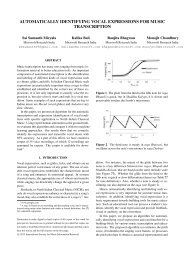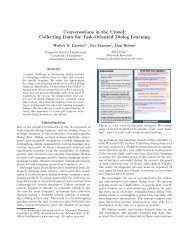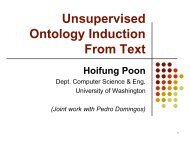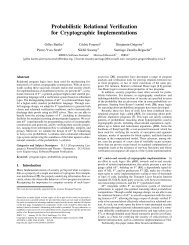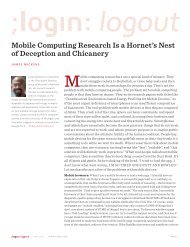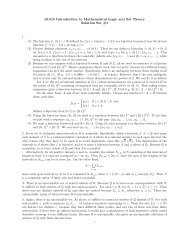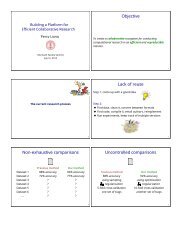On Intuitionistic Linear Logic - Microsoft Research
On Intuitionistic Linear Logic - Microsoft Research
On Intuitionistic Linear Logic - Microsoft Research
You also want an ePaper? Increase the reach of your titles
YUMPU automatically turns print PDFs into web optimized ePapers that Google loves.
Chapter 2<br />
Proof Theory<br />
1 Sequent Calculus<br />
As explained in Chapter 1, ILL arises from removing the structural rules of Weakening and<br />
Contraction. This has the effect of distinguishing between different formulations of the familiar<br />
connectives of IL. For example, in IL, we might formulate the ∧R rule in one of two ways.<br />
Γ − A Γ − B ∧ ′ R<br />
Γ − A ∧ B<br />
Γ − A ∆ − B ∧ ′′ R<br />
Γ, ∆ − A ∧ B<br />
However, we can see that with rules of Weakening and Contraction with can simulate one with the<br />
other.<br />
Γ − A Γ − B ∧ ′′ R<br />
Γ, Γ − A ∧ B Contraction ∗<br />
Γ − A ∧ B<br />
Γ − A Weakening ∗<br />
Γ, ∆ − A<br />
Γ, ∆ − A ∧ B<br />
∆ − B Weakening ∗<br />
Γ, ∆ − B ∧ ′ R<br />
In ILL since we do not have the structural rules these two possible formulations become distinct<br />
connectives. We shall use the terminology of Girard to describe these connectives: those where the<br />
upper sequent contexts are disjoint (as in (∧ ′′ R )) are known as the multiplicatives and those where<br />
the upper sequent contexts must be the same (as in (∧ ′ R )) are known as the additives. Thus for<br />
ILL we shall consider the following connectives:<br />
Connective Symbol<br />
Multiplicative Implication −◦ “<strong>Linear</strong> Implication”<br />
Conjunction ⊗ “Tensor”<br />
Additive Conjunction & “With”<br />
Disjunction ⊕ “Sum”<br />
It can be seen that there are some obvious omissions from this table, namely multiplicative disjunction<br />
and additive implication. Multiplicative disjunction ( . or “Par”) requires multiple conclusions<br />
which is beyond the scope of this thesis. (It was thought that it only made sense as a classical<br />
connective, but recent work by Hyland and de Paiva [43] shows how it can be considered as a<br />
intuitionistic connective.) The additive implication, ⋄−, can be formulated as follows.<br />
Γ − A B, Γ − C (⋄−L)<br />
Γ, A⋄−B − C<br />
Γ, A − B (⋄−R)<br />
Γ − A⋄−B<br />
However, this connective is generally ignored as its computational content seems minimal. 1 We shall<br />
do likewise and not consider this connective further.<br />
We have units for the two conjunctions and the (additive) disjunction. I is the unit for the<br />
tensor, t is the unit for the With, and f is the unit for the Sum.<br />
Of course the logic so far is extremely weak. Girard’s innovation was to introduce a new unary<br />
connective, !, (the so-called ‘exponential’) to regain the logical power. The exponential allows a<br />
1 Troelstra [75, Chapter 4] considers briefly additive implication in the context of a logic with just two implications.<br />
7



